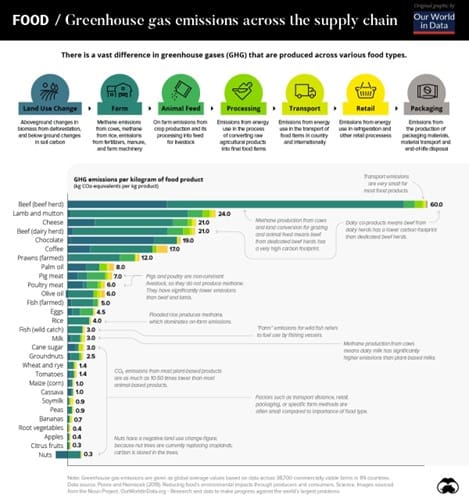Home Can I reduce my carbon footprint through my diet?
Yes, you really can! Your diet can have an impact on climate change. The production and consumption of food are significant contributors to greenhouse gas emissions, deforestation, and other environmental issues. By making conscious choices about what you eat, you can reduce your carbon footprint and contribute to mitigating climate change.

Source – The Visual Capitalist
Here are some ways your diet can help with climate change:
- Reduce Meat Consumption: As you can see from the chart above, the production of meat, particularly beef and lamb, is associated with high levels of greenhouse gas emissions. Livestock farming requires a lot of land for grazing and feed production, which results in deforestation (around 70% of deforestation in the Amazon has been linked to cattle pastures) contributing to biodiversity loss, soil erosion and therefore climate change. Deforestation is currently the second largest contributor of global GHG emissions at 20% – power generation is only a little ahead as the largest emitter at 25%. Energy use for livestock farming is also significant, with energy for heating, lighting, and other farming practices. Large amounts of water for irrigation, animal drinking and cleaning are also required. This can put a huge strain on water resources, particularly in areas where water is already scarce. Waste from livestock, including manure and other byproducts can also pollute water sources. Livestock farming also produces significant amounts of methane, which is a potent gas also contributing to climate change. Overall, the environmental impact of livestock farming, particularly red meat, is enormous, therefore if you’d like to lower your carbon footprint consider reducing your meat consumption, especially red meat, and opt for more plant-based protein sources like beans, lentils, tofu, and tempeh.
- Choose Sustainable Seafood: Overfishing and unsustainable fishing practices can harm marine ecosystems. Look for sustainable seafood options certified by organizations like the Marine Stewardship Council (MSC).
- Eat Locally and Seasonally: Buying locally grown and seasonal produce reduces the carbon footprint associated with transporting food long distances.
- Minimize Food Waste: Approximately one-third of all food produced globally is wasted. Reducing food waste not only saves you money but also reduces the energy and resources used in food production and transportation.
- Select Organic and Regenerative Agriculture: Organic farming practices often use fewer synthetic chemicals and prioritize soil health. Regenerative agriculture techniques can help sequester carbon in the soil.
- Support Sustainable Farming: Choose products from farms that follow sustainable and environmentally friendly practices. Look for certifications like USDA Organic or Fair Trade.
- Reduce Processed Foods: Many processed foods have a higher environmental impact due to packaging, processing, and transportation. Opt for whole foods whenever possible.
- Reduce Packaging Waste: Choose products with minimal or recyclable packaging to reduce waste.
- Drink Tap Water: Bottled water production and transportation contribute to greenhouse gas emissions. Using a reusable water bottle and drinking tap water can reduce your environmental impact.
- Advocate for Change: Beyond personal choices, consider advocating for policies and practices that promote sustainable and climate-friendly food production and distribution at the local, national, and global levels.
By making these dietary choices, you can reduce your individual carbon footprint and contribute to a more sustainable and climate-resilient food system.
Check out the food offerings of the hotels you promote and see if they offer a reduced carbon menu.
#climateaction #reduceemissions #climatechange
Photo in News
Recent Posts
©Baxter Media 2025
Back to top

















